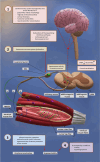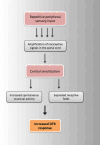Reevaluating fibromyalgia diagnosis: a proposal to integrate deep tendon reflex responses into current criteria
- PMID: 40172661
- PMCID: PMC11965154
- DOI: 10.1007/s00296-025-05846-y
Reevaluating fibromyalgia diagnosis: a proposal to integrate deep tendon reflex responses into current criteria
Abstract
Fibromyalgia is a complex condition characterized by widespread pain, fatigue, and various other symptoms. The symptoms of fibromyalgia overlap with numerous other disorders (e.g., infections, chronic fatigue syndrome), which makes diagnosis challenging. Existing diagnostic criteria for fibromyalgia rely particularly on subjective patient reports. Such a limitation may lead to both missed diagnoses and potential overdiagnoses. Recent research has identified significantly increased deep tendon reflex (DTR) responses in patients with fibromyalgia. The results also demonstrated the potential for DTR examination to help with the diagnostic process, particularly with ruling out fibromyalgia. The potential underlying mechanisms behind the increased DTR responses in fibromyalgia are central nervous system dysregulation, altered muscular properties, autonomic nervous system dysfunction, and accompanying conditions such as hypomagnesemia and anxiety. By integrating DTR responses into current diagnostic criteria sets, physicians may more effectively differentiate fibromyalgia from other conditions and avoid the pitfalls of misdiagnosis, as well as overdiagnosis. The use of DTR testing in the diagnostic evaluation of fibromyalgia shows promise. Yet, it has both advantages and limitations. The potential benefits of this approach include improved diagnostic accuracy, but challenges remain in its low specificity. This means that hyperreflexia testing alone is not definitive in diagnosing fibromyalgia. Nonetheless, given the high sensitivity, a decreased DTR response could still contribute to ruling out fibromyalgia.
Keywords: Diagnosis; Fibromyalgia; Hyperreflexia; Reflex, knee, abnormal; Reflex, triceps, abnormal.
© 2025. The Author(s).
Conflict of interest statement
Declarations. Conflict of interest: The authors declare no conflicts of interest regarding the publication of this article. Disclaimer: The authors state that no part of this manuscript, including the text and graphics, are copied or published elsewhere in whole or in part.
Figures


Similar articles
-
Diagnostic utility of deep tendon reflex responses in rectus femoris and triceps brachii in fibromyalgia: a clinical and electrophysiological study.Rheumatol Int. 2025 Feb 21;45(3):57. doi: 10.1007/s00296-025-05808-4. Rheumatol Int. 2025. PMID: 39982496 Free PMC article.
-
Diagnosis and differential diagnosis of fibromyalgia.Am J Med. 2009 Dec;122(12 Suppl):S14-21. doi: 10.1016/j.amjmed.2009.09.007. Am J Med. 2009. PMID: 19962492
-
Diagnostic role of deep tendon reflex latency measurement in small-fiber neuropathy.J Peripher Nerv Syst. 2007 Sep;12(3):223-31. doi: 10.1111/j.1529-8027.2007.00143.x. J Peripher Nerv Syst. 2007. PMID: 17868250
-
The Usefulness of Deep Tendon Reflexes in the Diagnosis of Lumbar Spine Diseases: A Narrative Review.Cureus. 2024 Mar 8;16(3):e55772. doi: 10.7759/cureus.55772. eCollection 2024 Mar. Cureus. 2024. PMID: 38586775 Free PMC article. Review.
-
Evaluation and differential diagnosis of fibromyalgia. Approach to diagnosis and management.Rheum Dis Clin North Am. 1989 Feb;15(1):19-29. Rheum Dis Clin North Am. 1989. PMID: 2644676 Review.
References
-
- Wolfe F, Smythe HA, Yunus MB, Bennett RM, Bombardier C, Goldenberg DL, Tugwell P, Campbell SM, Abeles M, Clark P et al (1990) The American College of Rheumatology 1990 criteria for the classification of fibromyalgia. Report of the multicenter criteria committee. Arthritis Rheum 33(2):160–172. 10.1002/art.1780330203 - PubMed
-
- Wolfe F, Clauw DJ, Fitzcharles MA, Goldenberg DL, Katz RS, Mease P, Russell AS, Russell IJ, Winfield JB, Yunus MB (2010) The American College of Rheumatology preliminary diagnostic criteria for fibromyalgia and measurement of symptom severity. Arthritis Care Res (Hoboken) 62(5):600–610. 10.1002/acr.20140 - PubMed
-
- Wolfe F, Clauw DJ, Fitzcharles MA, Goldenberg DL, Häuser W, Katz RS, Mease P, Russell AS, Russell IJ, Winfield JB (2011) Fibromyalgia criteria and severity scales for clinical and epidemiological studies: a modification of the ACR preliminary diagnostic criteria for fibromyalgia. J Rheumatol 38(6):1113–1122. 10.3899/jrheum.100594 - PubMed
-
- Wolfe F, Clauw DJ, Fitzcharles MA, Goldenberg DL, Häuser W, Katz RL, Mease PJ, Russell AS, Russell IJ, Walitt B (2016) 2016 revisions to the 2010/2011 fibromyalgia diagnostic criteria. Semin Arthritis Rheum 46(3):319–329. 10.1016/j.semarthrit.2016.08.012 - PubMed
Publication types
MeSH terms
LinkOut - more resources
Full Text Sources
Medical

